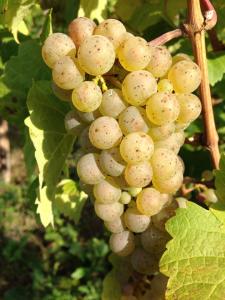
Peter Lauer’s iconic label
For me, 2011 is a difficult vintage in German Riesling. The summer was very warm, and the grapes ripened a lot which resulted in lower acidity levels in general. It made for really nice dry wines when I tried them in 2012, but by now, I find a lot of them to feel flabby and uninspiring. So in general, I tend to avoid 2011 German Rieslings, at least at the moment.
It’s nice when you come across a bottle that actually captures you and makes you come back to it. And that was exactly what this bottle of wine by Saar winery Peter Lauer did for me. Peter Lauer, now a member of the elite winemaker association VDP, has been making highly acclaimed wines for a while now, and while I still have not visited the winery (something I intend to remedy this summer), I have had a decent amount of their portfolio. Their labels are hard to miss, given their unique design, and there are many things that make this winery stand out:
They try to defy German wine laws by putting fantasy names that closely resemble abolished vineyard names on the label to truly designate terroir and where exactly the grapes were grown.
They also put the barrel number on the label, because traditionally this winery put the must from its different plots in different barrels to vinify them separately.
They tend to not use the usual designations of Kabinett or Spätlese, and it is rather the barrel number (the German word for barrel is “Fass”) that will indicate what style the wine is made in.
Their slogan is: “Riesling for advanced drinkers” (Riesling für Fortgeschrittene)…
The 2011 Peter Lauer Ayler Kupp “Kern” Riesling Fass 9 has 10% ABV with 35 grams of residual sugar/liter and hails from the Ayler Kupp vineyard, one of the prime locations along the Saar river. The “Kern” subsite is facing away from the Saar, on the far end of the Kupp. The winery considers it one of its premium sites, stocked with old vines. You can see it on this map:

Peter Lauer vineyard site map (Credit: Winery website)
The wine poured in a light yellow color like straw with hints of green. The nose was intense, with aromas of green apple and papaya, very fresh. The nose alone made me want to dive deeper into the wine. On the palate, it was light to medium bodied with a lot of heft to it. It was creamy, with lots of caramel, almost burnt caramel aromas (totally unexpected given its color!) and showed a lot of herbal character. I did not detect much fruit. The acidity was not noticeable, but not very prominent, but the sweetness was at the same time never overpowering. Towards the end, I detected some bitter aromas which did not quite fit in at that stage. The finish was of medium length. On the next day, the wine tasted a lot nuttier with walnut being the most prominent aroma on display.
This is not a Riesling as one usually expects a Riesling to be: The lack of fruit on the palate, the heaviness of the wine. There was so much going on on a different level than usually that made this wine a great experience. I am again and again surprised by what this grape can be capable of in the hands of the right winemakers. This wine is definitely worth a try and your time, especially in the darker months of the year. Peter Lauer wines are rather well available in the US.









